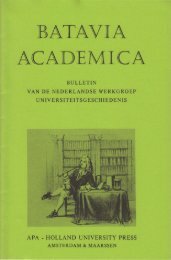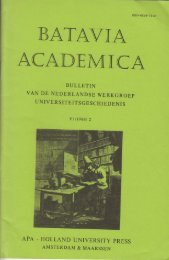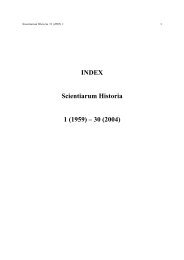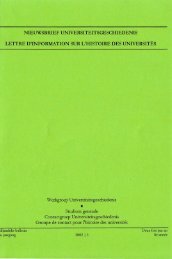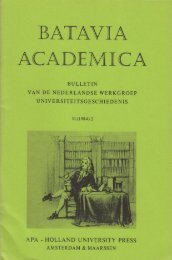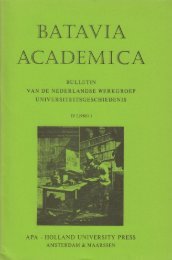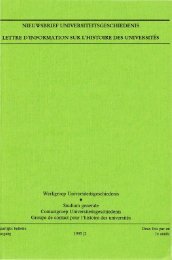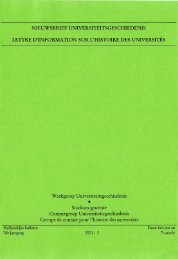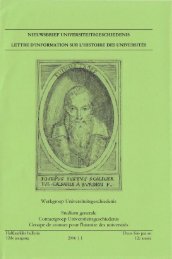the ocular harpsichord of louis-bertrand castel - Gewina
the ocular harpsichord of louis-bertrand castel - Gewina
the ocular harpsichord of louis-bertrand castel - Gewina
Create successful ePaper yourself
Turn your PDF publications into a flip-book with our unique Google optimized e-Paper software.
Castel's <strong>ocular</strong> <strong>harpsichord</strong> 55<br />
Ano<strong>the</strong>r author, closely related to <strong>the</strong> musical world <strong>of</strong> Castel's age, who<br />
discussed Castel's <strong>harpsichord</strong> was Francesco Algarotti. Voltaire had much<br />
admired his book // Newtonianismo per le dame from 1737, written in <strong>the</strong> form<br />
<strong>of</strong> a conversation between a teacher and his inquisitive pupil, a marquise, and it<br />
was quickly translated into French and into many o<strong>the</strong>r languages as well.<br />
Remarkably enough, considering <strong>the</strong> title <strong>of</strong> <strong>the</strong> book, in <strong>the</strong> part dealing with<br />
optics Algarotti defended <strong>the</strong> vibration <strong>the</strong>ory <strong>of</strong> Malebranche, in <strong>the</strong> form<br />
Malebranche finally gave it to reconcile it with Newton's prism experiments. The<br />
marquise accepted this <strong>the</strong>ory, as she said because "<strong>the</strong> fraternity between sound<br />
and light appeals to me", upon which her teacher answered: "I had expected,<br />
Madame, that this fraternity would please you, and I am convinced that <strong>the</strong><br />
<strong>ocular</strong> <strong>harpsichord</strong> and its <strong>ocular</strong> music, which arc going to present you a new<br />
brilliance, will be successful with you." What follow are a lot <strong>of</strong> jokes, but it<br />
remains doubtful whe<strong>the</strong>r Algarotti wholly rejected <strong>the</strong> idea as such.'"^<br />
The adoption <strong>of</strong> colour music as an art fully equal to music, interpreted as a<br />
wholly formal art, later was <strong>the</strong> choice <strong>of</strong> Immanuel Kant in his Kritik der<br />
Urteilskraft. Kant ordered <strong>the</strong> arts into three hierarchical pairs. First came<br />
rhetoric and poetry, both relating <strong>the</strong> Verstand or understanding with <strong>the</strong><br />
imagination. Next came sculpture and painting, connected with <strong>the</strong> Sinnesanschauung<br />
or sensory apperception and leaving <strong>the</strong> imagination a much<br />
more modest role to play. Last came music and Farbenkunst, both acting purely<br />
on <strong>the</strong> level <strong>of</strong> <strong>the</strong> sensations and not involving anything more than different<br />
degrees <strong>of</strong> tension <strong>of</strong> <strong>the</strong> sense organs. Kant, in accordance with his acceptance<br />
<strong>of</strong> Euler's vibration <strong>the</strong>ory <strong>of</strong> light in 1755, connected <strong>the</strong> sensations <strong>of</strong> each art<br />
with <strong>the</strong> velocity <strong>of</strong> <strong>the</strong> vibrations <strong>of</strong> <strong>the</strong> respective media. As he supposed <strong>the</strong><br />
existence <strong>of</strong> both tone and colour scales, his Farbenkunst cannot have been<br />
anything else but Castel's colour music, but <strong>the</strong>re is no explicit reference<br />
Vergleichungen entwickcln und ihre Ordnung und Unordnung empfinden. DiB Empfinden<br />
verursachet das Vergniigen und Anreilzen in alien Dingen, und das eigentliche Vergniigen der<br />
Musik beslehel in dem, solchen Unterschied augcnblicklich, und nach und nach in kurtzer Zeit<br />
mehrmals, zu bemercken. DiB erwecket die Scele, crhall sie beslandig munlcr, und vcrhindert. daO<br />
sie nicht auf einen albemen Glcichlaut verfalll. Kurtz: Es ist unstreiiig, daB dicB Farbenspiel<br />
ergetzen wird. Denn Musik ist nichts andcrs. als eine Ergetzlichkeit."<br />
Algarotti. Newtonianisme, p. 222: "la fratemite du Son & de la Lumiere me louche"; "J'ai<br />
bien juge, Madame, que cette fratemite vous plairoTt, & je ne desespere pas que le Clavecin des<br />
couleurs, & la .Musique des yeux qui vont lui donner un lustre nouveau, ne fasse fortune aupres de<br />
vous." Interestingly, <strong>the</strong> first extension <strong>the</strong> marquise thinks <strong>of</strong> is a "musique des ragouts", as did<br />
Prevost and Hogarth. At a certain moment, when .Algarotti became too frivolous, <strong>the</strong> translator<br />
defended Castel in a footnote! In <strong>the</strong> fully revised final edition <strong>of</strong> 1752 all references to Malebranche<br />
had disappeared, but Castel's <strong>harpsichord</strong> was still <strong>the</strong>re. The only joke left - if il was a<br />
joke - was <strong>the</strong> statement that "on such an instrument <strong>the</strong> eyes enjoy arias by Pergolesi and<br />
Rameau: and thanks to it it will be possible to have copied on cloth some lines sung by Caffariello.'<br />
(Chapter 6 <strong>of</strong> any later edition.)



